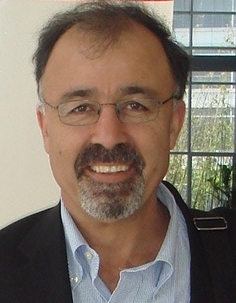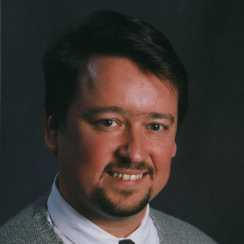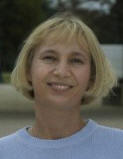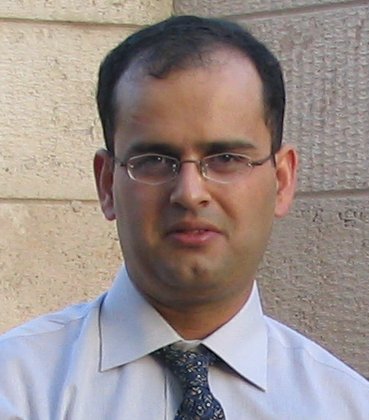Invited Speakers
Keynote
speakers:
|
 |
"Brain-Machine
Interfaces for Accurate Monitoring and Subsequent Treatment of
Central Neural System Functions"
Prof. Mohamad Sawan
Polytechnique Montréal
Montreal, Canada
http://www.polymtl.ca/recherche/rc/en/professeurs/details.php?NoProf=108
|
|
Abstract
Currently emerging
intracortical biosensing and treatment applications are promising
alternative to allow learning about the cortical organization, studying
the neural activity underlying cognitive functions and pathologies,
locating onset seizures, understanding neurons interactions, detecting
mind driven decisions, address complex central neural system
dysfunctions by both microelectrostimulation and drug delivery
Microsystems, etc. This talk covers
circuits and systems techniques used for the design and integration of
biosensing and treatment Microsystems. Such devices are interconnected
to intracortical neural tissues, and include low-power high-reliability
wireless link used to power up such implanted devices and
bidirectionally exchange data with external base station. Global view of
typical devices altogether with corresponding multidimensional
challenges will be described. Special attention will be paid to
automatic detection of neural interaction and to massively parallel
recording of action potentials, through large arrays of electrodes and
power management of these bioelectronic devices. On the other hand,
microstimulation in the primary visual cortex, which are intended to
recover vision for the blind through multisite large arrays of
electrodes, will be elaborated as case study of the intended treatments.
In addition, high-reliability wireless links are key blocks intended to
power up such implanted devices will be one of the topics of this talk.
|
|
Biographical Sketch
Mohamad Sawan was born in Lebanon, received the Ph.D. degree in 1990 in
electrical engineering, from Sherbrooke University, Canada. He joined
Polytechnique Montréal in 1991, where he is currently a Professor of
Microelectronics and Biomedical Engineering. His scientific interests
are the design and test of mixed-signal (analog, digital, RF, MEMS and
optic) circuits and Microsystems: design, integration, assembly
and validations.
These topics are oriented toward the biomedical and telecommunications
applications. Dr. Sawan is a holder of a Canada Research Chair in Smart
Medical Devices. He is leading the Microsystems Strategic Alliance of
Quebec (ReSMiQ) receiving membership support from 11 Universities.
He
is founder / co-founder of several International conferences such as
NEWCAS, BiOCAS, and ICECS, and he
is Editor/ Associate Editor of several International Journals such as
the IEEE Transactions on Biomedical
Circuits and Systems and the Springer
Mixed-signal Letters. He is the founder
of the Polystim Neurotechnologies Laboratory at Polytechnique Montréal.
Dr. Sawan published more than 450 papers in peer reviewed
journals and conference proceedings, offered more than 90 invited
talks/keynotes, and he was awarded 6 patents
pertaining to the field of biomedical sensors and actuators.
Dr. Sawan received several prestigious awards; the most important of
them are the Medal of Honor from the President of Lebanon, the
Bombardier Award for technology transfer, the Barbara Turnbull Award for
medical research in Canada, and the achievement Award from the American
University of Science and Technology. Dr.
Sawan is Fellow of the IEEE, Fellow of the Canadian Academy of
Engineering, Fellow of the Engineering Institute of Canada, and Officer
of the Quebec’s National Order.
|
| |
|
 |
"Composition imaging
using coherent scatter computed tomography for targeted management of
kidney stone disease"
Prof.
Ian Cunningham
Robarts Research Center
London, ON, Canada
http://www.robarts.ca/ian-cunningham
|
|
Abstract
The goal of medical research is to improve
health and quality of life. The goal of medical imaging research is to
develop instrumentation, methods and applications that provide images to
help diagnose disease and or make treatments for effective and less
invasive. This presentation will describe research in which physics is
being used to develop better management of kidney stone disease.
Approximately 10% of Canadians will suffer the often debilitating pain
of kidney stones. In addition, recurrence rates are very high (up to
75%) and hence it is critical to determine the mineral and protein
composition to select the most effective prevention strategies.
Unfortunately, many stones are heterogeneous and current analysis
methods do not provide the composition at the core of the stone that
started formation in the patient. This is where imaging can help. We
are developing a novel approach called coherent-scatter computed
tomography (CSCT) that combines the benefits of x-ray diffractometry
for composition analysis with cross-sectional imaging to produce maps of
protein and mineral distributions in the stone. These maps specifically
show the core composition which enables the physician to prescribe the
most appropriate treatment. In a clinical study currently underway, we
are finding that the core material is completely missed by current
methods in almost 25% of all patients having stones. The implication is
that imaging methods such as CSCT can be used to specifically target the
core and reduce recurrence.
|
|
Biographical Sketch
Dr. Ian Cunningham is a
professor and scientist at the Robarts Research Institute at The
University of Western Ontario and physicist at London Health Sciences
Centre. He directs a research team of graduate students and
post-doctoral fellows that are investigating new ways of acquiring and
displaying medical images using digital radiography and computed
tomography for improved health care.
|
| |
|
|
Distinguished speakers: |
| |
|
 |
"The never-ending quest to
understand biomaterial-cell interactions"
Dr.
Maud Gorbet
University of Waterloo
Waterloo, ON, Canada
http://www.systems.uwaterloo.ca/people/faculty/gorbet.html
|
|
Abstract
Biocompatibility of
materials plays a significant role in the success and failure of current
medical devices but also in the development of novel biomaterials. As
cells interact with materials, several biological mechanisms may be
induced, resulting in cell death and/or activation. This has the
potential to lead to significant complications for the patients such as
inflammation and fibrosis and ultimately device failure. As one
understands how cells interact with and respond to materials, further
material modification can be designed to promote the desired cell
response to improve biocompatibility. Drawing from her experience with
ophthalmic materials, Dr Gorbet will discuss how in vitro models can
contribute to the development of better biomaterials. |
|
Biographical Sketch
Dr. Maud Gorbet is a
faculty member within the Systems Design Engineering Department at
University of Waterloo. She is also cross appointed to the School of
Optometry. Her research and expertise focus on understanding
interactions between biological systems and biomaterials. She is well
recognized in the blood biocompatibility research area and her review on
biomaterial-associated thrombosis was selected as one of the 25 most
significant papers in the 25 years of publication of the journal
Biomaterials. While relatively new to the field of ophthalmic materials,
she has already made important contributions. Her post doctoral research
on cell interactions with contact lenses was an invited presentation at
the biennial meeting of the International Society for Contact Lens
Research (the “think tank” of contact lens research and industry) in
2007. Her approach to biocompatibility problems and knowledge of
cell-material interactions has led Dr. Gorbet to design new in vitro
models or modify existing ones to better reproduce the in vivo situation
and allow for a more complete assessment of the biocompatibility of
materials. While working in industry, she played a significant role in
characterizing the biocompatibility of a novel polymer to allow its
entry into clinical trials, gaining valuable experience as project
coordinator of biocompatibility studies in collaborative research
projects with university and industry partners. She is also a very
active member of the Community Outreach Program at University of
Waterloo, through her enthusiastic involvement as local team coordinator
for the First Lego League Ontario. This program encourages engineering
creativity amongst local students aged 9 through 14 by giving them the
opportunity to create teams that tackle an engineering problem and
create a Lego robotic structure that is able to complete a set of tasks
in a timely fashion.
|
| |
|
 |
"Scanning probe microscopy in biomedical research"
Dr. Zoya Leonenko
University of Waterloo
Waterloo, ON, Canada
http://biology.uwaterloo.ca/people/zoya-leonenko
|
|
Abstract
Scanning Probe Microscopy is a big and growing family of many nanoscale
characterization methods which are widely used in many areas including
physics, chemistry, biology, biomedical and nano-technology. One of
them, Atomic force microscopy (AFM) is a well-known scanning probe
microscopy technique which allows imaging and nanomanipulation on a
single molecule and nm scale. In this talk I will give introduction to
several scanning probe microscopy methods, and focus on Atomic Force
Microscopy (AFM), and Kelvin Probe Force Microscopy (KPFM), which we use
in my laboratory to investigate complex structure and function of lipid
films and lipid-protein interactions. Molecular arrangement of lipids
and proteins in monolayer or membrane gives rise to complex film
morphology as well as an electrical surface potential or non-uniform
charge distribution, which rule many biological processes and diseases.
I will give a review of current research projects in my laboratory, such
as a) study of structure and function of lung surfactant and how these
are affected by cholesterol; b) investigation of amyloid fibril
formation which is associated with Alzheimer’s disease.
|
|
Biographical Sketch
Dr. Leonenko’s holds a joint position of
Associate Professor in the
Department of Physics and Astronomy and the Department of Biology
at the University of Waterloo. She is also
a member of Waterloo Institute for Nanotechnology and a collaborative
member of Nanosciences Center at the University of Burgundy in Dijon,
France.
She received her PhD in Chemical Physics, in 1996, from Russian Academy
of Sciences, Novosibirsk, Russia, and did her postdoctoral training in
biophysics at University of Calgary, Canada.
Dr. Leonenko is
leading Biophysics research group at the University of Waterloo, Canada.
Her current research interests include scanning probe microscopy and
biophysics of lipid membrane and lipid-protein interactions, the role of
structural changes and physical properties of lipid template in
controlling biological processes and diseases, application of lipid
films in biomedical nanotechnology. Current projects include the study
of structure and function of lung surfactant; amyloid fibril formation
and toxicity in relation to Alzheimer’s disease; interaction of
nanoparticles with lipid and cell membrane, and development of
applications of lipid films in biomedical nanotechnology.
Leonenko’s group uses advanced optical, fluorescence and scanning probe
microscopy methods, such as atomic force microscopy (AFM), electrostatic
force microscopy (EFM), magnetic force microscopy (MFM) and Kelvin probe
force microscopy (FM-KPFM) and works on the development of novel methods
and applications of these methods in biophysics and biomedical
nanotechnology.
Dr. Leonenko has more than 60 publications in leading international
journals, such as Nanomedicine, Biophysical Journal, Biomedical
nanotechnology, Biophysica et Biochimica Acta, Langmuir, and presented
multiple invited talks in Canada and internationally. She is a member of
Material Research Society, American Physical Society, American
Biophysical Society, and Canadian Association of Physicists.
|
| |
|
 |
"Development of polymeric nanomaterials for
cancer therapy"
Dr.
Frank Gu
University of Waterloo
Waterloo, ON, Canada
http://nanomedicine.uwaterloo.ca/
|
| |
|
|
Biographical Sketch
Frank Gu received his Ph.D.
at Queen’s University in Canada, where he majored in chemical
engineering and was awarded with Canada Graduate Scholarship from
Canadian Natural Sciences and Engineering Research Council (NSERC). In
2006, he was award with NSERC Postdoctoral Fellowship to join the
Laboratory of Institute Professor Robert Langer lab at Massachusetts
Institute of Technology (MIT). In July 2008, Frank joined the Department
of Chemical Engineering at the University of Waterloo. His current
research interests are in the development of biomaterials for
nanomedicine and biopharmaceutics applications.
|
| |
|
 |
Blackberry Solution -
The Centerpiece of mHealth Reality
Dr.
Sasan Adibi
Research In Motion
Waterloo, ON, Canada
|
|
Abstract
The number of wearable
wireless sensors is expected to grow to 400 million by the year 2014
while we are expected to pass the 5.2 billion mark for the number of
operational mobile subscriber by the year 2011. All of this growth
requires an increasing number of mobile-based applications to be
deployed in the Machine-to-Machine (M2M) communications and eHealth/mHealth
(Electronic/Mobile Health) space. These emerging mobile applications
running on 3G and future 4G mobile networks, will partially be used in
telemedicine, establishing, maintaining, and transmitting healthcare
information, research, education, and training sectors. With WiMAX
rollout and LTE trials taking place around the world, the future is
already here.
We aim to take a closer look at these applications, specifically in
regards to the healthcare industry, such as blood-pressure, heart-pulse
monitor, glucometer, and other related medical applications. We believe
that the BlackBerry platform and the pertinent infrastructure (i.e., BES
“BlackBerry Enterprise Server”) is a logical and practical solution for
eHealth/mHealth/sensor and M2M deployments, which are considered in this
talk. |
|
Biographical Sketch
Sasan Adibi (BS'95,
MS'99, MS'05, PhD'10) has a PhD degree in Communication and Information
Systems and is currently involved in the design and implementation of
the next generation wireless and mobile applications in the health-care
industry. He has an extensive research background mostly in the areas of
Quality of Service (QoS) and Security. He is the first author of +30
journal/conference/book chapter/white paper publications and is a
co-editor of two books in the areas of 4th Generation Mobile Networks
and QoS. He also has strong industry experiences, having worked in a
number of high-tech companies, including: Nortel Networks and Siemens
Canada. He is currently a Member of Technical Staff at Research In
Motion (RIM), Canada. |
|
|